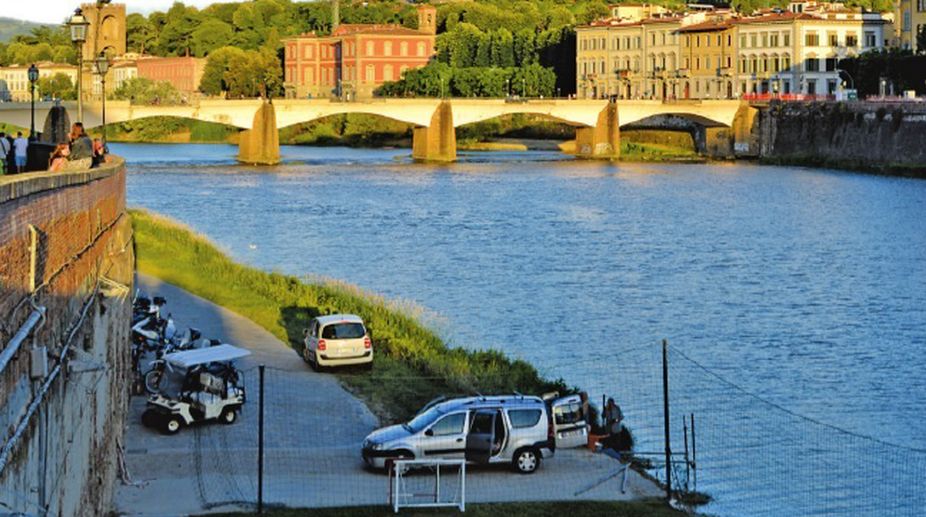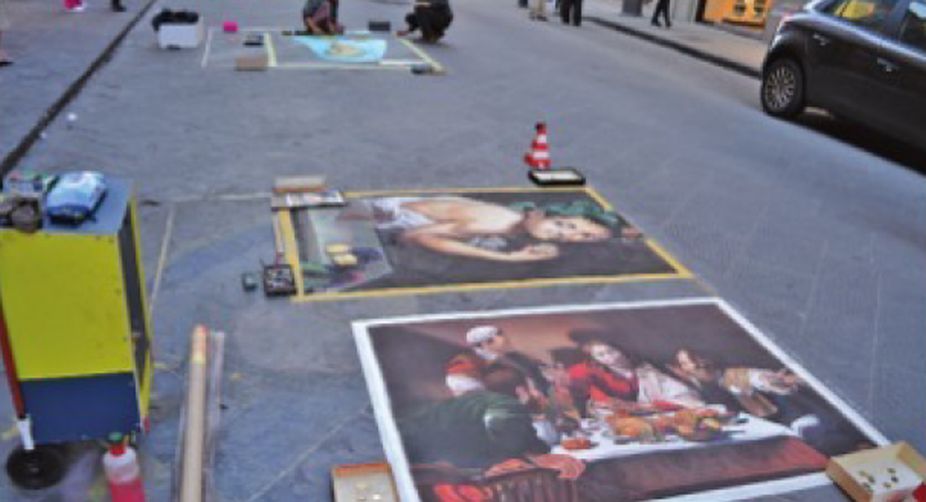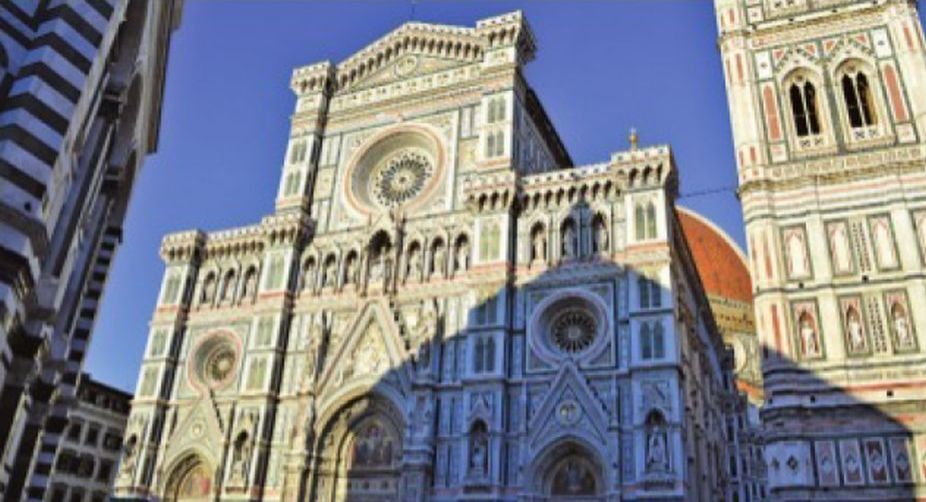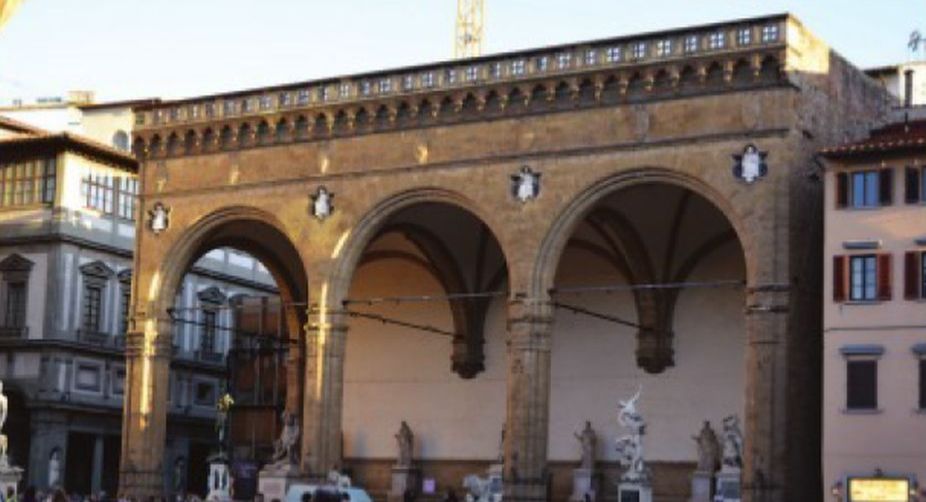Italy condemns Moscow terror attack, tightens security across country
Italy has condemned the terror attack at a suburban Moscow concert hall and stepped up security at key transportation, cultural,…
Florence enchants one with its wonderful atmosphere, steeped as it is in Renaissance art and architecture.

River Arno.
Florence in Italy is synonymous with the Renaissance and has long been viewed as one of Europe’s greatest art cities. From Michelangelo’s famous David to the canvases of Botticelli to the famed Duomo cathedral, Florence offers myriad experiences to art and architecture lovers. Naturally, it comes high on the list of the most-visited places in Italy and is always teeming with tourists.
We visited Florence in the peak of the tourist season in summer. We took the train from Rome and got down at the main station, Firenze Santa Maria Novella.
The station is an architecturally significant building with a long, dramatic metal and glass roof with many skylights spanning the entire walkway and no columns in between, thus giving a very open feeling. From the station, it was a short distance to the Piazza della Signoria, the most famous of Florence’s plazas.
Advertisement
The moment we set foot in the plaza, we were struck by the vibrant street life of the city. Music filled the air and every corner had violinists, guitarists or other musicians playing renditions of famous songs and compositions.

Shops and cafes surrounded the plaza and were filled with tourists. There were numerous statues within the plaza, including a copy of Michelangelo’s David, also referred to as the “Fake David”. We were told the statues signified antique Renaissance art.
Florence was the birthplace of the Italian Renaissance and was the most important city in Europe, politically, economically and culturally, from the 1300s to the 1500s.
A very famous Florentine, Filippo Brunelleschi, who lived during the time, had invented neoclassical architecture here and this had revolutionised the way every major European city — be it Rome, Paris, London or Barcelona — was being built. Brunelleschi is best remembered today for creating the huge brick dome of the Florence cathedral, the Duomo.
The Duomo was within walking distance from the Piazza della Signoria. As we walked past the plaza, the majestic brick dome appeared in sight. The great, eight ribbed dome and the neighbouring bell tower of the Palazzo Vecchio, Florence’s town hall, rose above the city skyline and was truly a sight to behold.
Interestingly, this dome was built by Brunelleschi after he won an open competition! It is said he took up the challenge to create the world’s biggest dome and painstakingly created two — one outer pointed dome concealing an inner one to withstand the structural challenges. The Duomo is still the largest brick dome in the world. This year is the 600th anniversary of design of the Duomo.

We decided to climb the steps that led to the top of the Duomo. Stained glass windows and frescoes greeted us on the way up. There were breathtaking views of the city as we peered out from the windows. Most of the original works of art inside the Duomo have now been removed and replaced with copies. The originals are housed in the Museum of the Works of the Duomo, just to the east of the Cathedral.
To us, the Duomo was definitely the defining eye catcher of Florence. It dominated the skyline and from every corner of the city, we could see clear views of this great dome.
After the climb down, we decided to give our tired feet some rest. We went into one of the famed openair cafes of Florence close to the Duomo, to be able to devour the sights and sounds of this magnificent cathedral.
A young lady was playing the violin nearby. In this lively environment, we were served freshly made spaghetti carbonara, gnocchis, thin-crust pizzas and the famed Italian dessert, tiramisu. The food was simply delicious!
The next day was planned for our visits to the art galleries. Our first stop was the Uffizi art gallery, which houses collections of Renaissance paintings and sculptures. We had booked our tickets online to avoid the huge queues.
We were able to see numerous famous paintings like Botticelli’s The Birth of Venus and Titian’s Venus of Urbino. Outside, we saw street performers playing violin duets and also people dressed as sculptures. Also on the street were amazing pieces of art, drawn by local artists. It was an enthralling experience.

From there, we went on to the Galleria dell’ Accademia. This museum houses many of the masterpieces of the Renaissance era, most famous being Michelangelo’s David and the unfinished Slaves. The statue of David is such a captivating piece of sculpture that it stuns you into silence for a few seconds. Proportion and symmetry take an amazing form in this masterpiece.
This museum also houses famous painter Giambologna’s Rape of the Sabines and Botticelli’s Madonna and Child and Madonna of the Sea. From the art galleries, we went to the Ponte Vecchio, the oldest and most famous bridge over the River Arno. It is the only Florentine bridge to survive World War II. It is lined with shops, mostly jewellers since the Renaissance days.
Towards evening we headed towards the Boboli Gardens, a beautiful landscaped garden with several remarkable sculptures. From these gardens, we could see wonderful views of the Duomo on the other side of the River Arno. Our last stop for the evening was the Piazzale Michelangelo, which was on top of a hill. Steps led up to the plaza.
As dusk fell and Florence lit up, we were treated to a mesmerizing view of the city from the plaza. Enjoying our gelatos (Italian ice-cream), we soaked in the ambience of this culturally rich city. The two days that we were in this fascinating city seemed to have passed by in a trance, for Florence enchants you with its wonderful atmosphere. It just seemed to be teasing us to come back again.
Advertisement